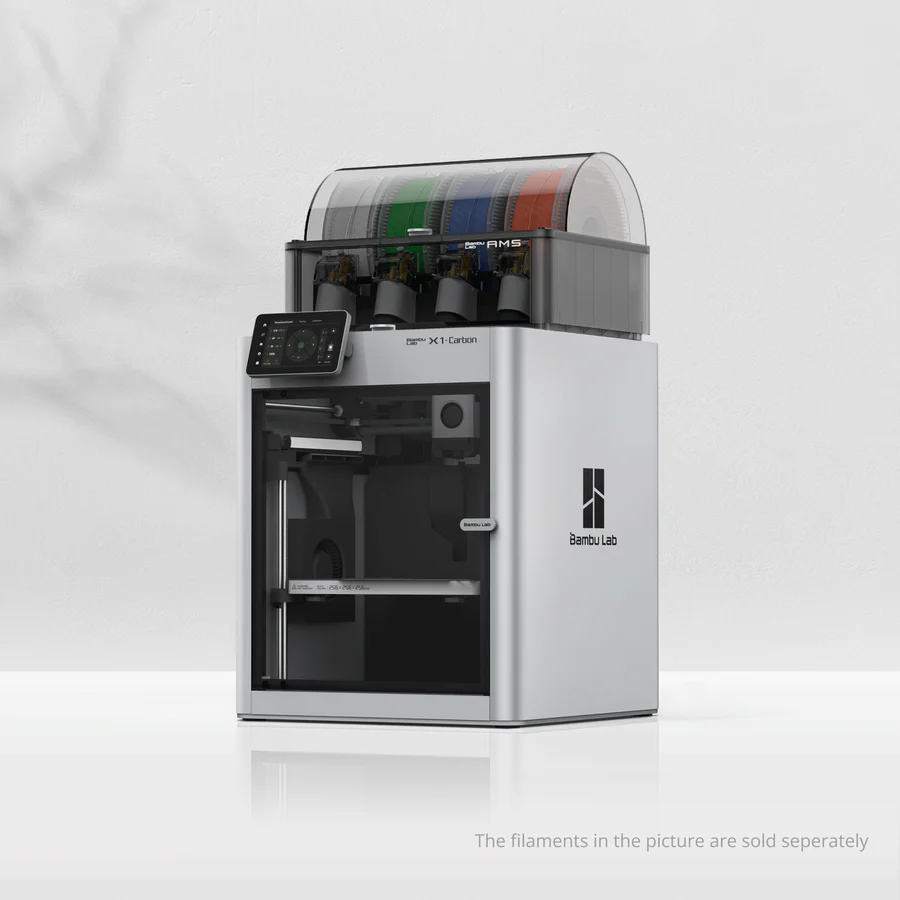Compare K1 Max vs X1 carbon
Comparison between the best 3D printers
Choose the best 3D printer at the best price. The cheapest 3D printers are here.
Buy a 3D printer here with 3D Fila.
 |
 |
|
| Model | K1 Max[BUY K1 Max] |
X1 carbon |
| Printing Material | Filament | Filament |
| Buy Filament for Creality 3D K1 Max | Buy Filament forBambu Lab X1 carbon | |
| Estimated price | $1300,00 | $1449,00 |
| Manufacturer | Creality 3D | Bambu Lab |
| Release Year | 2023 | 2023 |
| Print Volume [mm] | 300x300x300 | 256x256x256 |
| Printer Size [mm] | 435x462x526 | 389x389x457 |
| Weight [kg] | 18 | 14,13 |
| Power Loss Recovery | YES | YES |
| Enclosed printer | YES | YES |
| Bed Leveling | Automatic | Automatic |
| Filament End Sensor | YES | YES |
| Bed type | Heated | Heated |
| Power supply system | Direct Drive | Direct Drive |
| Standard nozzle | 0,4 | 0,4 |
| Maximum Nozzle Temperature [°C] | 300 | 300 |
| Maximum Bed Temperature [°C] | 100 | 120 |
| Maximum printing speed [mm/s] | 600 | 500 |
| Filament holder | YES | YES |
| Camera for supervision | YES | YES |
| Recommended filaments | ABS, PLA, PETG, TPU, PA, ASA, PC, PLA-CF, PA-CF, PET-CF | PLA, PETG, TPU, PVA, PA, PA-CF, Nylon, PC |
| Recommended slicers | Creality Print, Cura, Simplify, Slic3r, IdeaMaker e outros | Bambu Studio, Super Slicer, Cura, Prusa Slicer, Orca |
| Maximum Resolution [mm] | 0,1 | 0,1 |
| Processor | Quad ARM A7 1.2 GHz | |
| Display | Display touchscreen 4,3'' | Touchscreen 5'' |
| Power Supply | 350 W | |
| Connectivity | USB / Wi-Fi / Ethernet | Wifi, Bambu bus, Cartão SD |
| Operating systems | Windows, Mac, Linux | Windows, Linux, Macbook |
| Date of registration in the system | 2023-12-01 | 2024-04-10 |
| Release date | 2023 | 2023 |
| Extra features | The Creality K1 Max stands out as a fast Core XY 3D printer with a large build volume of 300 x 300 x 300 mm. It is fully enclosed and equipped with AI sensors to prevent print failures. This model has a smooth and flexible PEI build platform, and uses an automatic leveling system with LIDAR, as well as a filament run-out sensor. LAN, Creality Cloud and USB Flash Disk connectivity are available, as well as a 4.3-inch touchscreen interface. The K1 Max is robust, weighing in at 18 kg, and includes an AI camera and limited version of the Klipper firmware. Its motion system is solid and the printer is efficient with high-temperature filaments, but it is not silent. Assembly is 99% complete, requiring only minor adjustments before use. | The Bambu Lab X1 Carbon revolutionizes 3D printing with stunning design, high print speeds, and a streamlined user experience. It stands out with its CoreXY system, a hotend capable of reaching 300°C, allowing for a wide range of filaments. Its LiDAR-assisted bed leveling system, vibration compensation, and AMS multicolor printing capability raise the industry standard. Print quality is impressive, with the ability to fine-tune for perfection. The X1 Carbon, with its closed build volume, not only promises but also delivers one of the most advanced 3D printing experiences available to consumers. |
| Support for multiple colors and materials (AMS and CFS) | NO | YES |
Notes * |
||
| Cost-benefit | 7 / 10 | 7 / 10 |
| Hardware | 4.8 / 10 | 6.4 / 10 |
| Tela | . | . |
| Print volume | 4 / 10 | 4 / 10 |
| Performance | 5 / 10 | 4 / 10 |
| [BUY K1 Max] |
Conclusion |
| In comparing the Creality K1 Max and the Bambu Lab X1 Carbon, both 3D printers offer robust features that cater to different user needs, with each having distinct advantages. The K1 Max, priced lower than the X1 Carbon, provides a larger print volume and impressive maximum printing speed, making it an excellent choice for users who prioritize efficiency and build size. With its user-friendly features like automatic bed leveling and AI sensors, it ensures ease of use and print reliability, which is particularly appealing for hobbyists and small-scale production. On the other hand, the Bambu Lab X1 Carbon, despite being more expensive, justifies its price with advanced technologies such as LiDAR-assisted bed leveling, multi-material printing capabilities, and higher maximum bed temperature, which expands its versatility. This model is geared toward users who require precision and are willing to invest in a premium printing experience. Ultimately, the choice between the K1 Max and the X1 Carbon depends on the buyer's specific needs and budget. If cost-effectiveness and larger build volume are priorities, the K1 Max is the better option. However, for those seeking cutting-edge technology and multiple material capabilities, the Bambu Lab X1 Carbon stands out as a leading contender. Each printer excels in its domain, ensuring that users can find the right fit for their 3D printing endeavors. |

